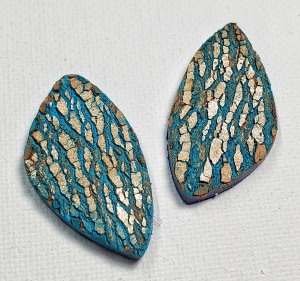 I post these daily 3×3 photos of stuff I see on my walks ( I post on both IG and FB). Sometimes they are pretty, sometimes they are grungy – but I’m always focusing on composition, lighting and texture. So the other day when I posted this photo of the lamp, someone posted a comment about calling me out to replicate it in clay (Lyn, wasn’t that you?). Well, honestly, 2 seconds after I finished the cropping/editing of the 3×3 I was thinking about doing this in clay. About the third time I walked past these lamps, I was pretty sure of what was going to happen.
I post these daily 3×3 photos of stuff I see on my walks ( I post on both IG and FB). Sometimes they are pretty, sometimes they are grungy – but I’m always focusing on composition, lighting and texture. So the other day when I posted this photo of the lamp, someone posted a comment about calling me out to replicate it in clay (Lyn, wasn’t that you?). Well, honestly, 2 seconds after I finished the cropping/editing of the 3×3 I was thinking about doing this in clay. About the third time I walked past these lamps, I was pretty sure of what was going to happen.
Now I am familiar with the technique steps for crackle, and I’ve done one great crackle for every 3 not-so-great crackles. But that didn’t stop me – heck, I even MIXED a clay for this! I’m using Sculpey Souffle (OF COURSE) and I mixed a little Poppy Seed into Concrete to create a dark grey instead of using a black (homage to the photo).
I used a #2 (0 is my widest) layer of the background grey color, and a #4 layer for the Igloo. I preheated my dual speed heat gun and quickly set the white layer – about 15 seconds. I let it cool until I could comfortably touch and I check for that partial curing. With Souffle, it’s REALLY easy to tell by touch if that top layer is partially cured.
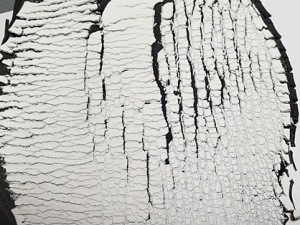 I ran it back through the pasta machine on #3 and got this great crackle (I also hand pulled it in certain areas as well.
I ran it back through the pasta machine on #3 and got this great crackle (I also hand pulled it in certain areas as well.
Okay, so I was pretty happy with it. I saw some areas that kind of looked like the peeling paint.
I had an idea to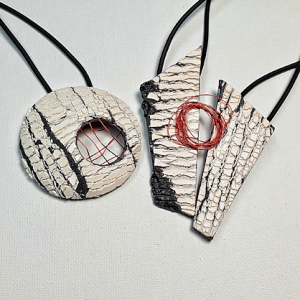 use my hand-made templates to cut two pieces and then link with with messy circles of red wire. But then I really wanted to weave some wire to reflect the lamp in the photo. So, I did both..
use my hand-made templates to cut two pieces and then link with with messy circles of red wire. But then I really wanted to weave some wire to reflect the lamp in the photo. So, I did both..
Cutting crackle requires a straight down cut with your clay blade, I wouldn’t try doing it with an Exacto-type blade. Or use a cutter like I did for the round pendant.
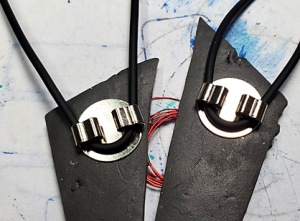 The next issue was how to actually string the pendants. I’ve been using the bolo findings for lots of things other than bolos lately and they worked out perfectly for BOTH of these pendants. The circular pendant didn’t really have enough area for a Montarse Easy Back and I KNEW the wire wouldn’t hold these two sides firmly. (That wire has tiny dots of Clear Liquid Sculpey bonding it to the pendant by the way). So TA DA! Fiendishly clever I think…
The next issue was how to actually string the pendants. I’ve been using the bolo findings for lots of things other than bolos lately and they worked out perfectly for BOTH of these pendants. The circular pendant didn’t really have enough area for a Montarse Easy Back and I KNEW the wire wouldn’t hold these two sides firmly. (That wire has tiny dots of Clear Liquid Sculpey bonding it to the pendant by the way). So TA DA! Fiendishly clever I think…
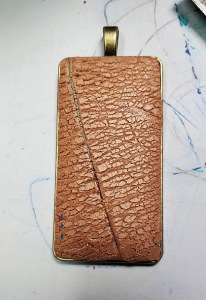 So then I saw a nice piece of marbled scrap clay with violets, golds and turquoise colors and I thought, “Oh syn! Crackled copper over marbled clay!” And I also wanted to do another white crackle over a dark blue. So I set both sets of sheets up the same way, preheated heat gun, 15 seconds each. But THIS time I decided to let them cool all the way down since the Copper felt a little stretchy still. 20/20 hind sight – NOT A GOOD IDEA APPARENTLY. The clays crackled, but were too stiff to let the bottom accent layers didn’t spread the crackle. Too BLAH for me.
So then I saw a nice piece of marbled scrap clay with violets, golds and turquoise colors and I thought, “Oh syn! Crackled copper over marbled clay!” And I also wanted to do another white crackle over a dark blue. So I set both sets of sheets up the same way, preheated heat gun, 15 seconds each. But THIS time I decided to let them cool all the way down since the Copper felt a little stretchy still. 20/20 hind sight – NOT A GOOD IDEA APPARENTLY. The clays crackled, but were too stiff to let the bottom accent layers didn’t spread the crackle. Too BLAH for me.
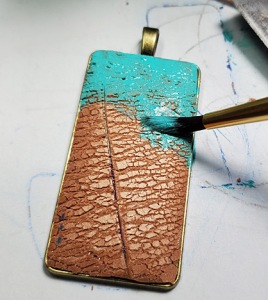 So, out came the paints. If you know me, you know what color this is that I’m using – it’s a turquoise color in a cheap craft paint. I brushed it onto the RAW clay and wiped off the upper surfaces with a baby wipe. I also added some hints of a slightly darker turquoise color as well. These craft paints are quite chalky when dry – which I like for a verdigris type effect. Shake/stir them well before using to really get that chalky look.
So, out came the paints. If you know me, you know what color this is that I’m using – it’s a turquoise color in a cheap craft paint. I brushed it onto the RAW clay and wiped off the upper surfaces with a baby wipe. I also added some hints of a slightly darker turquoise color as well. These craft paints are quite chalky when dry – which I like for a verdigris type effect. Shake/stir them well before using to really get that chalky look.
I had some larger chunk areas but the whole surface was still the copper color. But applying the paint on the raw clay really added interest.
So after bak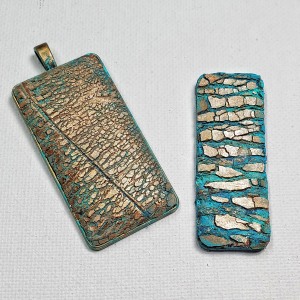 ing, I was pretty pleased with the outcome and muttered to the dogs, “Yeah, I meant to do that!”
ing, I was pretty pleased with the outcome and muttered to the dogs, “Yeah, I meant to do that!”
You can see the how I use two colors of turquoise in the pendant on the right.
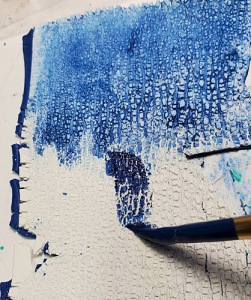 Now the blue/white sheet had interesting fine texture, but the darker background didn’t show through, so I used a dark blue paint. Now this is a craft paint as well, but fun fact (that is a totally incorrect use of the paint) – if you don’t stir the paints the stuff at the top will often look more like a stain – especially in darker colors. So I just took the top off and only used the clearish stuff at the top to create a blue stain that I wiped in some areas, scrubbed in some areas and didn’t touch at all in some areas. Look at the difference in the texture between the top and bottom!
Now the blue/white sheet had interesting fine texture, but the darker background didn’t show through, so I used a dark blue paint. Now this is a craft paint as well, but fun fact (that is a totally incorrect use of the paint) – if you don’t stir the paints the stuff at the top will often look more like a stain – especially in darker colors. So I just took the top off and only used the clearish stuff at the top to create a blue stain that I wiped in some areas, scrubbed in some areas and didn’t touch at all in some areas. Look at the difference in the texture between the top and bottom!
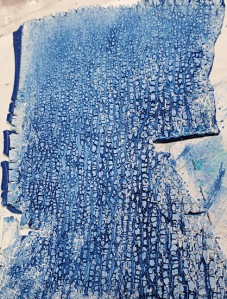 Now THIS looks like fun! Like really old, thready denim? My grungy lil heart is happy..well almost..
Now THIS looks like fun! Like really old, thready denim? My grungy lil heart is happy..well almost..
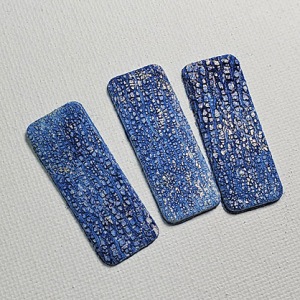 But just for the heck of it, I got out my gelli plate and added very fine swirls of light gold acrylic to the upper surfaces.
But just for the heck of it, I got out my gelli plate and added very fine swirls of light gold acrylic to the upper surfaces.
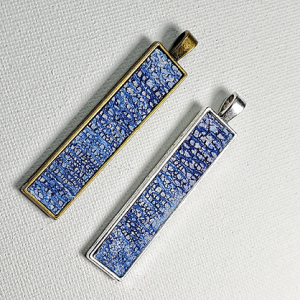 I could wear one of these 3 crackled pendants just about every day! (The findings are from Amazon and they come with clear domed plastic- I guess you are supposed to put paper underneath or something? Don’t get rid of those plastic pieces. They are GREAT to lay on the clay and use to first determine where you want to cut and then just trim around them for an almost perfect fit. These type bezels are called “pendant trays” -Amazon: ABBECIAO 24 pcs
I could wear one of these 3 crackled pendants just about every day! (The findings are from Amazon and they come with clear domed plastic- I guess you are supposed to put paper underneath or something? Don’t get rid of those plastic pieces. They are GREAT to lay on the clay and use to first determine where you want to cut and then just trim around them for an almost perfect fit. These type bezels are called “pendant trays” -Amazon: ABBECIAO 24 pcs
Anyway, I’m kind of thinking maybe one of the tricks to great crackle is the timing on when to thin the heated layers. Apparently allowing them to cool completely wasn’t it. I can’t imagine that thinning the clay while it is still hot will work that well, so I’m opting for the warmish to touch method next time like my first work at the top of this tutorial!
xoxo, syn
